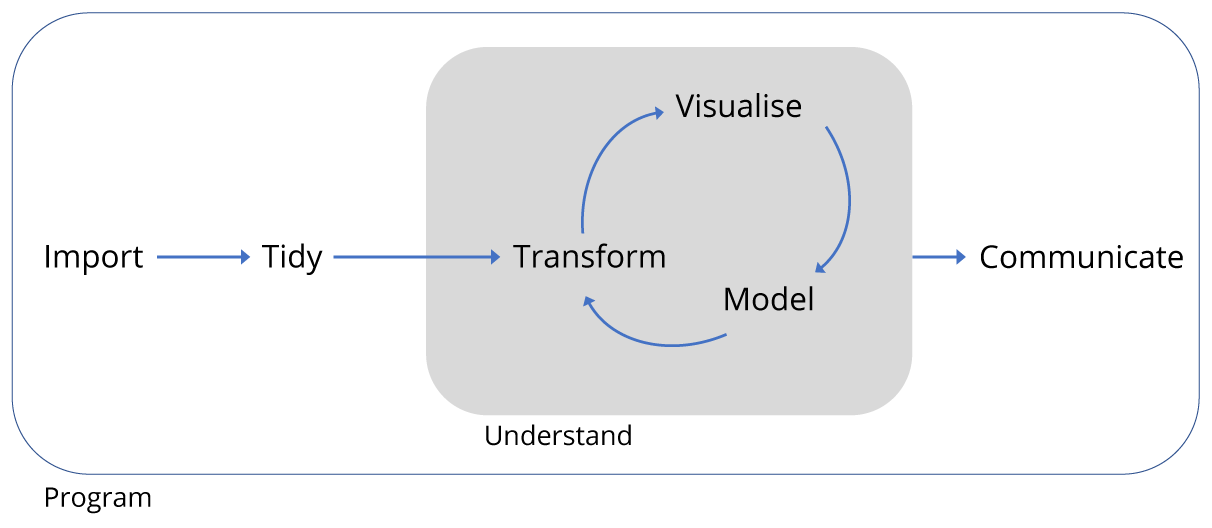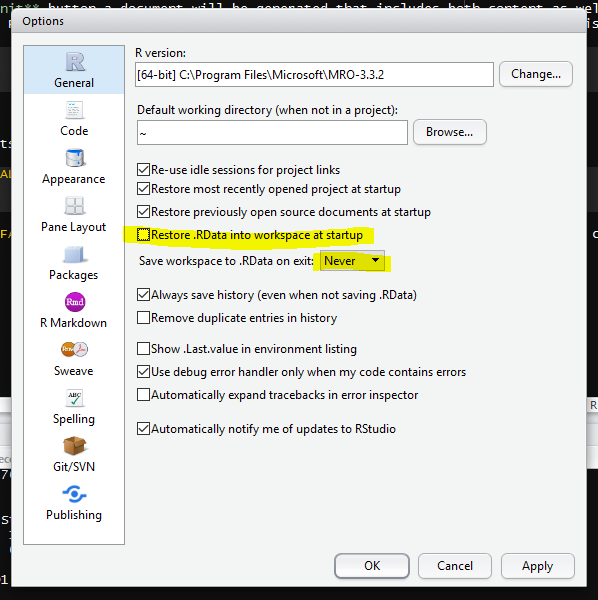Chapter 1 Introduction
There are many resources for learning R on the web. Much of Chapters 1, 2, 3 and 4 derive from a Data Carpentry lesson using ecological data that I have previously reworked, which in turn takes a lot from Hadley Wickham’s R for Data Science aka R4DS. Follow the links to access those materials.
Chapter 5 deals with some statistical transformations and visualisation methods in the context of proteomics data.
Whilst finally in Chapter 6 there is some advice about how to build upon the materials covered here.
In terms of philosophy:
The primary motivation for using tools such as R is to get more done, in less time and with less pain.
And the overall aim is to understand and communicate findings from our data.

Figure 1.1: Data project workflow.
As shown in Figure 1.1 of typical data analysis workflow, to acheive this aim we need to learn tools that enable us to perform the fundamental tasks of tasks of importing, tidying and often transforming the data. Transformation means for example, selecting a subset of the data to work with, or calculating the mean of a set of observations. We’ll cover that in Chapter 5.
But first…
1.1 What are R and RStudio?
“There are only two kinds of languages: the ones people complain about and the ones nobody uses”
Bjarne Stroustrup
R is a programming language that follows the philosophy laid down by it’s predecessor S. The philosophy being that users begin in an interactive environment where they don’t consciously think of themselves as programming. It was created in 1993, and documented in (Ihaka and Gentleman 1996).
Reasons R has become popular include that it is both open source and cross platform, and that it has broad functionality, from the analysis of data and creating powerful graphical visualisations and web apps.
Like all languages though it has limitations, for example the syntax is initially confusing.
Take for example the word environment…
1.1.1 Environments
An environment is where we bring our data to work with it. Here we work in a R envrionment, using the R language as a set of tools. RStudio is an integrated development environment, or IDE for R programming. It is regularly updated, and upgrading enables access to the latest features.
The latest version can be downloaded here: http://www.rstudio.com/download
1.2 Why learn R, or any language ?
We can write R code without saving it, but it’s generally more useful to write and save our code as a script. Working with scripts makes the steps you used in your analysis clear, and the code you write can be inspected by someone else who can give you feedback and spot mistakes.
Learning R (or any programming language) and working with scripts forces you to have deeper understanding of what you are doing, facilitates your learning and comprehension of the methods you use:
- Writing and publishing code is important for reproducible resarch
- R has many thousands of packages covering many disciplines.
- R can work with many types of data.
- They is a large R community for development and support.
- Using R gives you control over your figures and reports.
1.3 Finding your way around RStudio
Let’s begin by learning about RStudio, the Integrated Development Environment (IDE).
We will use R Studio IDE to write code, navigate the files found on our computer, inspect the variables we are going to create, and visualize the plots we will generate. R Studio can also be used for other things (e.g., version control, developing packages, writing Shiny apps) that we don’t have time to cover during this workshop.
R Studio is divided into “Panes”, see Figure 1.2.
When you first open it, there are three panes,the console where you type commands, your environment/history (top-right), and your files/plots/packages/help/viewer (bottom-right).
The enivronment shows all the R objects you have created or are using, such as data you have imported.
The output pane can be used to view any plots you have created.
Not opened at first start up is the fourth default pane: the script editor pane, but this will open as soon as we create/edit a R script (or many other document types). The script editor is where will be typing much of the time.

Figure 1.2: The Rstudio Integrated Development Environment (IDE).
The placement of these panes and their content can be customized (see menu, R Studio -> Tools -> Global Options -> Pane Layout). One of the advantages of using R Studio is that all the information you need to write code is available ina single window. Additionally, with many shortcuts, auto-completion, and highlighting for the major file types you use while developing in R, R Studio will make typing easier and less error-prone.
Time for a philosphical diversion…
1.3.1 What is real?
At the start, we might consider our environment “real” - that is to say the objects we’ve created/loaded and are using are “real”. But it’s much better in the long run to consider our scripts as “real” - our scripts are where we write down the code that creates our objects that we’ll be using in our environment.
As a script is a document, it is reproducible
Or to put it another way: we can easily recreate an environment from our scripts, but not so easily create a script from an enivronment.
To support this notion of thinking in terms of our scripts as real, we recommend turning off the preservation of workspaces between sessions by setting the Tools > Global Options menu in R studio as shown in Figure 1.3:

Figure 1.3: Don’t save your workspace, save your script instead.
1.4 Where am I?
R studio tells you where you are in terms of directory address like so:

Figure 1.4: Your working directory
If you are unfamiliar with how computers structure folders and files, then consider a tree with a root from which the trunk extends and branches divide. In the image above, the ~ symbol represents a contraction of the path from the root to the ‘home’ directory (in Windows this is ‘Documents’) and then the forward slashes are the branches. (Note: Windows uses backslashes, Unix type systems and R use forwardslashes).
It is good practice to keep a set of related data, analyses, and text self-contained in a single folder, called the working directory. All of the scripts within this folder can then use relative paths to files that indicate where inside the project a file is located (as opposed to absolute paths, which point to where a file is on a specific computer). Working this way makes it a lot easier to move your project around on your computer and share it with others without worrying about whether or not the underlying scripts will still work.

Figure 1.5: A typical directory structure
1.5 R projects
RStudio also has a facility to keep all files associated with a particular analysis together called a project.
Creating a project creates a working directory for you and also remembers its location (allowing you to quickly navigate to it) and optionally preserves custom settings and open files to make it easier to resume work after a break.
Figure 1.6: Creating a R project
Below, we will go through the steps for creating an “R Project”:
- Start R Studio (presentation of R Studio -below- should happen here)
- Under the
Filemenu, click onNew project, chooseNew directory, thenEmpty project - Enter a name for this new folder (or “directory”, in computer science), and
choose a convenient location for it. This will be your working directory
for the rest of the day (e.g.,
~/bspr-workshop) - Click on “Create project”
- Under the
Filestab on the right of the screen, click onNew Folderand create a folder nameddatawithin your newly created working directory. (e.g.,~/bspr-workshopdata) - Create a new R script (File > New File > R script) and save it in your working
directory (e.g.
bspr-workshop-script.R)
1.6 Naming things
Jenny Bryan has three principles for naming things that are well worth remembering.
When you names something, a file or an object, ideally it should be:
- Machine readable (no whitespace, punctuation, upper AND lowercase…)
- Human readable (makes sense in 6 months or 2 years time)
- Plays well with default ordering (numerical or date order)
1.7 Seeking help
If you need help with a specific R function, let’s say barplot(), you can type:
?barplotIf you can’t find what you are looking for, you can use the rdocumention.org website that searches through the help files across all packages available.
A Google or internet search “R <task>” will often either send you to the appropriate package documentation or a helpful forum question that someone else already asked, such as Stack Overflow or the RStudio Community.
1.7.1 Asking for help
As well as knowing where to ask, the key to get help from someone is for them to grasp your problem rapidly. You should make it as easy as possible to pinpoint where the issue might be.
Try to use the correct words to describe your problem. For instance, a package is not the same thing as a library. Most people will understand what you meant, but others have really strong feelings about the difference in meaning. The key point is that it can make things confusing for people trying to help you. Be as precise as possible when describing your problem.
If possible, try to reduce what doesn’t work to a simple reproducible example otherwise known as a reprex.
For more information on how to write a reproducible example see this article.
References
Ihaka, Ross, and Robert Gentleman. 1996. “R: A Language for Data Analysis and Graphics.” Journal of Computational and Graphical Statistics 5 (3): 299–314.